It was our second morning in Sardinia. After a bountiful breakfast we were riding along 30 miles of coast road that could cause California’s Big Sur Highway 1 to look a bit boring. A couple of hours later found us in the Gennargentu Mountains, where the well-paved byways, twisting and turning like a triple helix make Tennessee’s Tail of the Dragon resemble U.S. 60 in Oklahoma. I’ve been on a lot of roads in a lot of countries, and have to say that I was quite astonished at the superb riding possibilities on the Mediterranean islands of Sardinia (Italy) and Corsica (France)—presuming you like twisty, turny roads. This type of riding is not necessarily everybody’s choice, but it is mine. I would say this tour is best suited for very good riders.
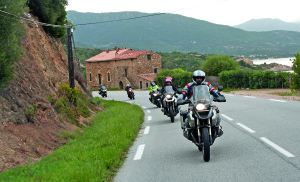
Both of these islands are covered with mountains and had pretty much been economic backwaters until about 25 years ago. Then the appeal of increased tourism prompted the governments to upgrade the roads, with the goat trails curling around the hillsides now covered in good asphalt. Twenty miles without getting out of third gear is a wonder—and strenuous. A 125-mile day can seem mighty long.
Back to the beginning, with 14 of us flying into Barcelona, Spain, and all convening for dinner, two Canadians, three Mexicans and nine Americans; 10 riders, four passengers. We would get our motorcycles in the morning and go off for a break-in 100-mile ride to the nearby mountains. That was a great day, with great roads and a great lunch featuring the famed local sausage and tomato/garlic bread.
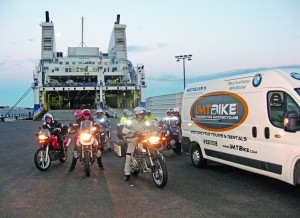
Late that afternoon, we arrived at the ferry dock; loading the bikes was no problem, with the crew tying them down. There is something undeniably pleasant about long-distance ferryboats, I find: walking around the deck, settling down for the night in a cabin with a window, the soothing rumble of the distant engine. Dawn saw us heading for the dock at Porto Torres in Sardinia and, after a shipboard breakfast, we had a brisk unloading.
Regrouping on the dock, we headed east along the coast to the small fishing port of Castelsardo, easy sweepers on a little-trafficked road. A bit of background: Sardinia is an island of some 9,000 square miles (roughly the size of New Hampshire), which has been populated for more than 8,000 years. The hilltop castle that is the focus of this port was built in the 13th century, and most towns have their own castle, as the island was divided among many little kingdoms…until 1861, when the various Sardinian chiefs voted to join the new Kingdom of Italy.
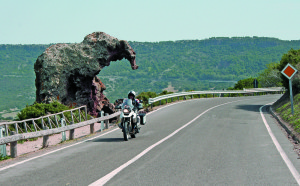
From Castelsardo, we headed southwest into the interior to get our first taste of what Sardinian riding would be like…twisty! The island is covered with hills and low mountains, the roads following the trails of yore. We had two guides, Scott (the head of IMTBike) and Martin, and they would trade-off riding and driving the chase truck with our luggage. The motorcycle guide would set a good pace, and he expected the 10 bikes following to stretch out over a mile or more, everybody riding at his or her own comfortable speed. If anybody wanted to go off on their own, they all had the address of that night’s hotel in the tour handbook, which also included maps. I should add that this arrangement is pretty much standard fare for organized motorcycle tours in Europe.
The first night on the island was in a pleasant hotel in the coastal town of Alghero, with a walk along the seafront to get to dinner. In the morning, we rode south down the coast for one of the more spectacular rides I have ever enjoyed, the aforementioned 30 miles of uninterrupted curvy roads, hills to the left, sea to the right and no traffic to speak of. Even better riding was ahead that day, as we crossed over the island to Arbatax on the east side, on the Tyrrhenian Sea—which separates Sardinia from the Italian mainland. Our roads took us into the Gennargentu Natural Park, going through the highest village on the island at a respectable 3,000-plus feet.
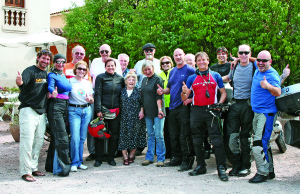
The next day was more romping through the Gennargentu, and six of us (including two passengers) were on our own. That evening’s destination of the Su Gologone was a whimsically rambling hotel built by two architects over many, many years. When Sue and I checked in, Rita, the woman behind the desk, gave us our key and said the room was on top of the hill. Being lazy, I asked if she didn’t have something closer to the reception. You will like it, she promised. So right! It was a two-room suite with a large deck and two-person bathtub, once occupied by the singer/actress Madonna when she was doing a film in Sardinia some years ago. The hotels we stayed at were really a cut above the ordinary, with no telling what a room would be like.
The hotel also had a very traditional restaurant, with the meats cooked in front of an open fire. The local delicacy is a sausage made of wild boar, domestic pork and fennel. Scrumptious!
The next day was a “rest” day, and some folk went gallivanting with Martin, others to the beach, while Sue and I listened to Rita’s advice and took a well-made dirt road over the mountain behind the hotel to the site of a 4,000-year-old village, or Nuraghe, as these stone buildings are called, which dot the island. Lots of history here.
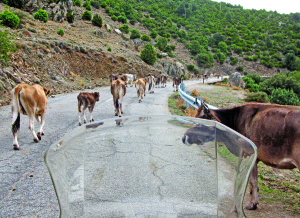
Next we saddled up and headed north for Corsica through the cork-tree forests. When you open a bottle of wine, its cork may have come from Sardinia, one of its main exports. One aspect of ferries is that we needed to be at the port at least two hours before departure in order to clear the paperwork. Everything else is adjustable, but ferries operate on strict schedules. We could see Corsica from the port of Santa Teresa, and the crossing to Bonifacio took only an hour. And what a sight greeted us! Limestone cliffs rising hundreds of feet above the sea, and sitting on top was our Hotel Santateresa, with stupendous views out across the straits back to Sardinia.
If we thought the Sardinian roads were twisty, these were even twistier. Corsica is about half the size of Sardinia (think Connecticut), with less than 300,000 inhabitants and many more mountains. The island has been called The Mountain in the Sea as it has over 20 peaks more than 6,500 feet high—and these rise almost straight up out of the water. A third of the island is considered natural parkland. The roads are wonderful—if you like changing gears 50 times or more every mile. We went up the east coast to Solenzara, and then deviously crossed over to Ajaccio on the west; very devious indeed, including the famed 4,000-foot Bavella Pass, less than 20 convoluted miles from the coast.
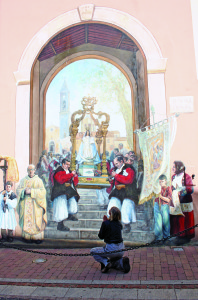
After another rest day, the next two were probably the most dramatic of the two weeks of riding, as the roads often hugged the coast, carved out of the rock cliffs above the sea. Generally the pavement was in good order, though in places the road was being improved and some caution was needed. We stopped in Calvi for lunch, where the huge citadel, begun over 800 years ago, dominates the port. It is home to the only parachute regiment in the French Foreign Legion, and these soldiers are known as the toughest of the tough. I’d hate to be an MP on Saturday night.
From there it was less than 50 miles to Saint Florent, a beautiful town, and our seaside hotel’s restaurant rated a Michelin star. It was an interesting dinner, quite tasty, but presentation seemed to be of more importance than gustation; the risotto was elegantly served and delicious, but too little of it. Maybe that is why most customers at these starred restaurants look elegantly thin.
The last day on the island we went around the northern peninsula, again on roads high above the sea on the west side, down lower on the east as the road wended back to the ferry port at Bastia. The loading there was a little different, as we had to go to the third deck by riding up a long metal ramp. But all was well, and the crew had a nifty system for securing the bikes, using a padded U-shape bar that went over each saddle.
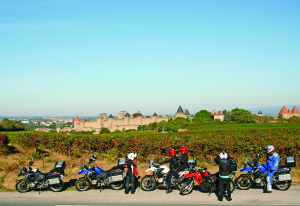
After a pleasant night aboard, in the early dawn we landed at the port of Marseille. I thought we might have a bit of trouble getting out of the second biggest city in France, but the guides had it all figured out, and come mid-afternoon we were riding up the hill toward the double-walled town of Carcassonne, one of the most magnificent sights in all of France. In the late 13th century, the French king built that second wall around the city and the place became impregnable. Our hotel was just outside the gates, and we could look up and see the great walls.
On the penultimate day, we rode up to the 4,700-foot Chioula Pass and had a wonderful picnic on the grass, the snowcapped Pyrenees in the distance. Then we made a run over the (almost) 8,000-foot pass at Envalira and into Andorra, a tiny little tax-free principality that is essentially one big shopping mall for the Spanish and French. Our final night on the road was just over the Spanish border in La Seu d’Urgell. A last morning was spent twisting and turning through the Sierra del Cadi and over the 5,900-foot Toses Pass, and then down into the valley for the run back to Barcelona.
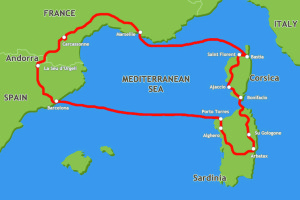
It was great trip, especially the islands, and I would definitely recommend it for any jaded type who is looking for a new adventure. Different roads, different cultures—though I lived in Europe for many years, this was a very pleasant eye-opener.
IMTBike offers motorcycle tours in Europe and Morocco. For more information visit imtbike.com or call (412) 468-2453.
(This article Adventure on the Islands: Riding Sardinia and Corsica with IMTBike was published in the March 2013 issue of Rider magazine.)







